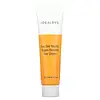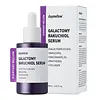What's inside
What's inside
 Key Ingredients
Key Ingredients

 Benefits
Benefits

 Concerns
Concerns

 Ingredients Side-by-side
Ingredients Side-by-side

Water
Skin ConditioningGalactomyces Ferment Filtrate
HumectantButylene Glycol
HumectantCetyl Ethylhexanoate
EmollientCetearyl Alcohol
EmollientCaprylic/Capric Triglyceride
MaskingGlycerin
HumectantPropanediol
SolventPentylene Glycol
Skin ConditioningCetearyl Olivate
1,2-Hexanediol
Skin ConditioningMacadamia Integrifolia Seed Oil
Skin ConditioningBifida Ferment Lysate
Skin ConditioningLactobacillus Ferment
Skin ConditioningTripeptide-1
Skin ConditioningPalmitoyl Tripeptide-1
Skin ConditioningPalmitoyl Pentapeptide-4
Skin ConditioningHexapeptide-9
Skin ConditioningHexapeptide-11
Skin ConditioningCopper Tripeptide-1
Skin ConditioningCeramide NP
Skin ConditioningCeramide Ns
Skin ConditioningCeramide As
Skin ConditioningCeramide AP
Skin ConditioningCeramide EOP
Skin ConditioningPanthenol
Skin ConditioningArginine
MaskingSorbitan Olivate
EmulsifyingSorbitan Stearate
EmulsifyingAdenosine
Skin ConditioningCaprylyl Glycol
EmollientPhytosphingosine
Skin ConditioningCholesterol
EmollientSodium Hyaluronate
HumectantHydrogenated Lecithin
EmulsifyingSoluble Proteoglycan
Skin ConditioningBetaine
HumectantAllantoin
Skin ConditioningAcrylates/C10-30 Alkyl Acrylate Crosspolymer
Emulsion StabilisingPolyglyceryl-10 Laurate
Skin ConditioningStearic Acid
CleansingEthylhexylglycerin
Skin ConditioningWater, Galactomyces Ferment Filtrate, Butylene Glycol, Cetyl Ethylhexanoate, Cetearyl Alcohol, Caprylic/Capric Triglyceride, Glycerin, Propanediol, Pentylene Glycol, Cetearyl Olivate, 1,2-Hexanediol, Macadamia Integrifolia Seed Oil, Bifida Ferment Lysate, Lactobacillus Ferment, Tripeptide-1, Palmitoyl Tripeptide-1, Palmitoyl Pentapeptide-4, Hexapeptide-9, Hexapeptide-11, Copper Tripeptide-1, Ceramide NP, Ceramide Ns, Ceramide As, Ceramide AP, Ceramide EOP, Panthenol, Arginine, Sorbitan Olivate, Sorbitan Stearate, Adenosine, Caprylyl Glycol, Phytosphingosine, Cholesterol, Sodium Hyaluronate, Hydrogenated Lecithin, Soluble Proteoglycan, Betaine, Allantoin, Acrylates/C10-30 Alkyl Acrylate Crosspolymer, Polyglyceryl-10 Laurate, Stearic Acid, Ethylhexylglycerin
Galactomyces Ferment Filtrate 95%
HumectantNiacinamide
SmoothingBakuchiol
AntimicrobialPanthenol
Skin ConditioningCollagen
Moisturising1,2-Hexanediol
Skin ConditioningHydroxyacetophenone
AntioxidantSimmondsia Chinensis Seed Oil
EmollientTocopheryl Acetate
AntioxidantPropanediol
SolventButylene Glycol
HumectantCentella Asiatica Extract
CleansingCarbomer
Emulsion StabilisingAlgin
MaskingCeramide NP
Skin ConditioningCannabis Sativa Seed Extract
EmollientAdenosine
Skin ConditioningGeranium Maculatum Oil
MaskingGalactomyces Ferment Filtrate 95%, Niacinamide, Bakuchiol, Panthenol, Collagen, 1,2-Hexanediol, Hydroxyacetophenone, Simmondsia Chinensis Seed Oil, Tocopheryl Acetate, Propanediol, Butylene Glycol, Centella Asiatica Extract, Carbomer, Algin, Ceramide NP, Cannabis Sativa Seed Extract, Adenosine, Geranium Maculatum Oil
Ingredients Explained
These ingredients are found in both products.
Ingredients higher up in an ingredient list are typically present in a larger amount.
1,2-Hexanediol is a synthetic liquid and another multi-functional powerhouse.
It is a:
- Humectant, drawing moisture into the skin
- Emollient, helping to soften skin
- Solvent, dispersing and stabilizing formulas
- Preservative booster, enhancing the antimicrobial activity of other preservatives
Adenosine is in every living organism. It is one of four components in nucleic acids that helps store our DNA.
Adenosine has many benefits when used. These benefits include hydrating the skin, smoothing skin, and reducing wrinkles. Once applied, adenosine increases collagen production. It also helps with improving firmness and tissue repair.
Studies have found adenosine may also help with wound healing.
In skincare products, Adenosine is usually derived from yeast.
Learn more about AdenosineButylene Glycol (or BG) is used within cosmetic products for a few different reasons:
Overall, Butylene Glycol is a safe and well-rounded ingredient that works well with other ingredients.
Though this ingredient works well with most skin types, some people with sensitive skin may experience a reaction such as allergic rashes, closed comedones, or itchiness.
Learn more about Butylene GlycolCeramide NP is a type of ceramide and formally known as ceramide 3.
Ceramides are intercellular lipids naturally found in our skin that bonds dead skin cells together to create a barrier. They are known for their ability to hold water and thus are a great ingredient for dry skin.
Ceramides are an important building block for our skin barrier. A stronger barrier helps the skin look more firm and hydrated. By bolstering the skin ceramides act as a barrier against irritating ingredients. This can help with inflammation as well.
If you would like to eat ceramides, sweet potatoes contain a small amount.
Read more about other common types of ceramides here:
Ceramide AP
Ceramide EOP
Galactomyces Ferment Filtrate (GFF) is a yeast traditionally used to make the Japanese alcoholic beverage, sake.
GFF has moisturizing and antioxidant properties.
Studies show GFF improves our skin's natural moisturizing factors (NMF). Our NMF consists of many components that naturally moisturize our skin. Having healthy NMF keeps our skin plump, protected, and hydrated.
This ingredient tells our skin to create more filaggrin, an important component for NMF.
Filaggrin gathers all the structural proteins in our outer layer of skin and creates a tight barrier, helping to protect our skin against allergens and bacteria. This also helps prevent moisture loss.
Thanks to its antioxidant properties, GFF also protects our skin against oxidative stress and UV induced inflammation.
One study found GFF helped regulate sebum (oil) production and keratin in participants.
GFF may not be fungal-acne safe. We recommend speaking with a professional if you have concerns.
Many components of sake, such as GFF, are studied for their anti-aging benefits today. This is because sake brewers are known to have youthful hands.
Learn more about Galactomyces Ferment FiltratePanthenol is a common ingredient that helps hydrate and soothe the skin. It is found naturally in our skin and hair.
There are two forms of panthenol: D and L.
D-panthenol is also known as dexpanthenol. Most cosmetics use dexpanthenol or a mixture of D and L-panthenol.
Panthenol is famous due to its ability to go deeper into the skin's layers. Using this ingredient has numerous pros (and no cons):
Like hyaluronic acid, panthenol is a humectant. Humectants are able to bind and hold large amounts of water to keep skin hydrated.
This ingredient works well for wound healing. It works by increasing tissue in the wound and helps close open wounds.
Once oxidized, panthenol converts to pantothenic acid. Panthothenic acid is found in all living cells.
This ingredient is also referred to as pro-vitamin B5.
Learn more about PanthenolPropanediol is an all-star ingredient. It softens, hydrates, and smooths the skin.
It’s often used to:
Propanediol is not likely to cause sensitivity and considered safe to use. It is derived from corn or petroleum with a clear color and no scent.
Learn more about Propanediol